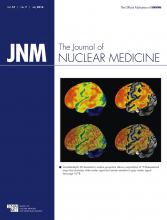Chemokines and their counterpart, chemokine receptors, are a group of molecules that play a key role in regulating the trafficking of cells throughout the body. Cells that express chemokine receptors are attracted to tissues with a high concentration of the respective chemokines. Activation of chemokine pathways exerts beneficial effects on cell survival and proliferation and thereby supports the attracted cells in their functionality in host tissue (1). This mechanism is relevant for tumor spread and progression, because many tumor cells express chemokine receptors (2). It is also important in inflammatory processes and in the response to tissue damage (3), because immune cells and progenitor cells strongly express chemokine receptors. Accordingly, chemokine receptors have emerged as a target for therapy in tumors, inflammatory conditions, and regenerative approaches (1,2,4).
The chemokine–chemokine receptor axis has therefore emerged as an attractive imaging target (5–7). Visualization and quantification of this molecular pathway may help in oncology (8), by
See page 1124
defining tumor aggressiveness and the likelihood of response to chemokine-targeted therapy. It may also play a role in inflammatory conditions, by determining localization and intensity of inflammatory cell accumulation.
Inflammation is well known to be a key contributor to pathogenesis and progression of atherosclerosis (9). Clinically, it has been shown that inflammatory conditions outside the cardiovascular system, such as periodontitis and arthritis, increase the risk for cardiovascular events (10). Basic studies, on the other hand, have shown that inflammation contributes to the rupture of vulnerable atherosclerotic plaques and that ischemic events caused by plaque rupture result in aggravation of the systemic inflammatory state and hence in aggravation of atherosclerotic lesions (11), establishing a vicious circle of disease progression. As a consequence, the development and implementation of molecular imaging approaches targeting the inflammatory component of atherosclerosis has been the subject of extensive research in cardiovascular medicine. 18F-FDG has been successfully used in observational studies (12) and—more recently—in clinical trials (13) to determine the prognostic value of vessel wall inflammation and its response to drug interventions. Additionally, a broad spectrum of other, more specific markers of inflammation has been tested in experimental and clinical settings of atherosclerosis (14). But the search for useful imaging assays has not ended and continues to be fueled by the increasing spectrum of antiinflammatory therapies, which require guidance by diagnostic tests for selecting useful candidates and for monitoring therapy effects.
In their most recent work published in The Journal of Nuclear Medicine, Luehmann et al. address the aforementioned issues in an innovative way (15). They introduce a DOTA-64Cu–labeled comblike nanoparticle functionalized with viral macrophage inflammatory protein II (vMIP-II) for PET imaging of a broad range of chemokine receptors. When compared with a prior marker of the same group, the nanoparticle displays prolonged blood retention over approximately 24 h for circulation to inflammatory regions, facilitating in vivo detection (6). In wire-injury–accelerated and passive atherosclerosis models, selective elevated uptake of 64Cu-vMIP-II-comb is identified at the affected arterial wall. Ex vivo validation is provided, showing that in vivo uptake is proportional to the relative plaque size and associated with increased expression of a panel of chemokine receptors and F4/80 staining of macrophages. These data provide initial proof of principle that the novel chemokine receptor–targeted tracer may be used for in vivo detection of the inflammatory component of atherosclerosis.
This initial work lays a foundation for subsequent studies that need to focus on establishing a firm role for the novel tracer in defining the interaction between the immune system and the cardiovascular system. Quantitative techniques need to be developed and tested in other animal models before clinical translation. The imaging agent is not specific for 1 chemokine receptor subtype but rather binds to an entire family of receptors, which may be an advantage with regard to signal strength because a larger number of binding sites are available. It may, however, also be a disadvantage because minor changes of one chemokine receptor may be masked or even counterregulated by changes in other receptors, making the detection of subtle differences difficult. Other groups and prior work of the same group, for example, chose to focus on specific chemokine receptors such as CXCR4 or CCR5 and explored their role in cardiovascular disease (16,17). Another aspect that is promising and challenging at the same time is the use of nanoparticles and 64Cu for labeling. Although the nanoparticle may be further modified to exert therapeutic effects besides its diagnostic potential (18), and although 64Cu is well suited and well established for labeling, the availability of the radiometal 64Cu still needs to be expanded to broaden acceptance and to support clinical practicability.
In summary, implementation of chemokine receptor–targeted molecular imaging is a next step toward a more specific interrogation of inflammatory processes, which clearly goes beyond the currently available techniques that are based on less specific tracers such as 18F-FDG. This may be useful in providing more detailed insights into the pathomechanisms of inflammatory diseases such as atherosclerosis, and it will help in the implementation and evaluation of novel therapies.
Footnotes
Published online Mar. 10, 2016.
- © 2016 by the Society of Nuclear Medicine and Molecular Imaging, Inc.
REFERENCES
- Received for publication February 22, 2016.
- Accepted for publication February 22, 2016.







